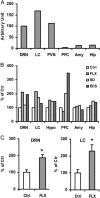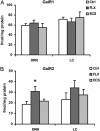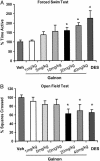A role for galanin in antidepressant actions with a focus on the dorsal raphe nucleus
- PMID: 15647369
- PMCID: PMC545581
- DOI: 10.1073/pnas.0408891102
A role for galanin in antidepressant actions with a focus on the dorsal raphe nucleus
Abstract
Selective serotonin reuptake inhibitors, such as fluoxetine (FLX), are the most commonly used drugs in the treatment of major depression. However, there is a limited understanding of their molecular mechanism of action. Although the acute effect of selective serotonin reuptake inhibitors in elevating synaptic serotonin concentrations is well known, the clinical amelioration of depressive symptoms requires 14-21 days of treatment, suggesting that numerous other rearrangements of function in the CNS must take place. In the present study, we demonstrated that 14 days of FLX treatment up-regulated galanin mRNA levels by 100% and GalR2-binding sites by 50%, in the rat dorsal raphe nucleus, where galanin coexists with serotonin. Furthermore, a galanin receptor antagonist, M40, attenuated the antidepressant-like effect of FLX in the forced swim test, a rodent preclinical screen commonly used to evaluate antidepressant-like efficacy. Direct activation of galanin receptors by a galanin receptor agonist, galnon, was found to produce an antidepressant-like effect in the same task. Two other antidepressant treatments also affected the galaninergic system in the monoaminergic nuclei: Electroconvulsive shock elevated galanin mRNA levels in dorsal raphe nucleus, whereas sleep deprivation increased galanin mRNA levels in the locus coeruleus, further underlining the connection between activation of the galaninergic system and antidepressant action of various clinically proven treatments.
Figures





References
-
- Duman, R. S., Heninger, G. R. & Nestler, E. J. (1997) Arch. Gen. Psychiatry 54, 597-606. - PubMed
-
- Mann, J. J. (1999) Neuropsychopharmacology 21, 99S-105S. - PubMed
-
- Schloss, P. & Henn, F. A. (2004) Pharmacol. Ther. 102, 47-60. - PubMed
-
- Branchek, T. A., Smith, K. E., Gerald, C. & Walker, M. W. (2000) Trends Pharmacol. Sci. 21, 109-117. - PubMed
-
- Vrontakis, M. E. (2002) Curr. Drug Targets CNS Neurol. Disord. 1, 531-541. - PubMed
Publication types
MeSH terms
Substances
Grants and funding
LinkOut - more resources
Full Text Sources
Other Literature Sources
Research Materials

